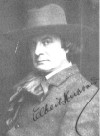


There are several places to start telling the story of Charles S. Hall. One of these centers around Elbert Hubbard, the Roycroft and East Aurora, New York. Elbert Hubbard, once a soap salesman for the Larkin Soap Co., of Buffalo, NY, came to East Aurora, NY in 1884 after severing his ties with John Larkin. Hubbard had been bitten by the literary bug and published his first book in 1891. After leaving Larkin he had enrolled as a special student at Harvard for a year. Though he was bored with the academic life he did find there the time, research facilities, and inspiration to pursue further writing.
In the Spring of 1894, long an admirer of John Ruskin, Elbert Hubbard decided to go to England with the hopes of meeting another Ruskin enthusiast, William Morris. It was more than a common interest in Ruskin that caused Hubbard to want to meet the sixty-year-old artist, poet, author, manufacturer, and publisher. Here was a kindred spirit, and Hubbard wanted to emulate him and do in the United States what Morris had done so successfully in England. He was particularly interested in Morris' Kelmscott Press which, in a matter of just a few years, was already becoming world famous for its output of superbly printed, illuminated, and leather bound books.

Hubbard returned to East Aurora and began to plan and build his "campus" of artisans - which he called The Roycroft. Through the years that followed, Hubbard brought artists the likes of Karl Kipp (metalwork), Dard Hunter (design), Alexis Jean Fournier and Sandor Landeau (painting), Frederick Kranz (leatherwork), William Wallace Denslow (designer of the Roycroft's sea horse emblem and later the illustrator of the Wizard of Oz), Jerome Connor (sculpture), Carl Ahrens (pottery and painting), Jules Gaspard (etchings) and others to East Aurora to create their works of art. The crafts that were produced by the Roycroft grew from illuminated and bound books to all sorts of leather work, furniture, copper and brass ware and oil paintings—all in the Arts and Crafts style.

This period from 1895 to 1915 extends from the time of the formation of the Roycroft Shops to the tragic deaths of Elbert and Alice Hubbard in the Lusitania sinking by a German U-boat on May 7, 1915. It was the most productive and most influential period in terms of the Hubbard/Roycroft impact on the American scene. The Roycroft survived, however, under the able guidance on his son, Elbert Hubbard II, until 1938 when it became a belated victim of the Great Depression that followed the stock market crash of 1929.